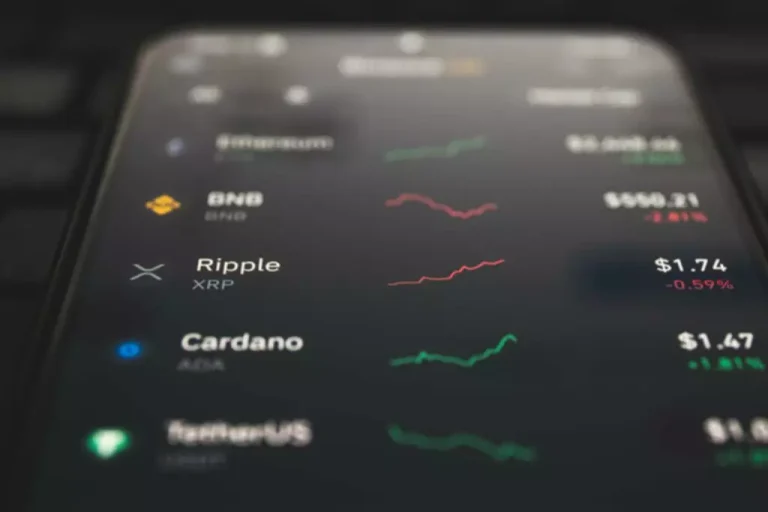Content
And other cryptocurrencies (aka altcoins) like Ethereum (ETH), Solana (SOL), and Dogecoin (DOGE) are just as—if not more—susceptible to https://www.xcritical.com/ wild price swings. For example, Vox cites a fascinating graphic on “The Musk Effect,” or the phenomenon of how strongly the value of Bitcoin is affected by Elon Musk’s tweets. If it makes you nervous that one person’s Twitter account has a huge influence over the value of your investments, good. Having the value of your investments be at the whim of one person’s fickle opinion sounds like a huge risk to me.
Investors Have Routinely Overestimated Bitcoin’s Volatility
The strong relationship implies that distortions to the long-term equilibrium of both indices are temporary and correcting over time. Blockchain is a digital ledger that’s stored on a crypto volatility decentralized network of computers. Each block of data is linked together like a chain, making it secure and transparent.
Strategies for Trading Crypto During Volatile Phases
In other words, new capital inflows will Proof of stake not move the market or the marginal buyer or seller as much. As to be expected, a young and nascent commodity or asset class with a small market cap is more likely to experience higher volatility as new capital flows into the asset. Bitcoin has been no exception with regular volatility in the triple digits, even breaching 200% on an annualized basis in its early years. The content published on this website is not aimed to give any kind of financial, investment, trading, or any other form of advice. BitDegree.org does not endorse or suggest you to buy, sell or hold any kind of cryptocurrency.
Technical Analysis 101 What Are the 4 Types of Trading Indicators?

The significance of these estimators lies in their ability to retain the critical information encoded in the sign of returns, which is otherwise lost when volatility is measured through the sum of squared or absolute value returns. The market participants are not necessarily rational in the cryptocurrency market, as the massive presence of retail investors exacerbates idiosyncratic volatility in unstable market conditions (Low and Marsh 2019; Ozdamar et al. 2022; Wen et al. 2019). From the 100 cryptocurrencies, we exclude stablecoinsFootnote 4 from our analysis since we are interested in volatility fluctuations that are not expected within that category of digital assets, remaining with 87 entities. Then, we queried from PolygonFootnote 5 the stock prices of the 42 companies included in the Nasdaq technology index with the same granularity. To compare the two asset classes, we consider the historical period between the year 2020 and year 2022 (up to October).
A comparison of cryptocurrency volatility-benchmarking new and mature asset classes
Crypto.com may not offer certain products, features and/or services on the Crypto.com App in certain jurisdictions due to potential or actual regulatory restrictions. Navigating crypto market swings requires a well-thought-out strategy and disciplined approach. Understanding these factors and their interplay is essential to navigate market swings and make informed decisions in the ever-changing cryptocurrency landscape. Similarly, technological advancements and innovations within the crypto space can trigger market swings as traders react to new possibilities. Here aresome of the top strategies to trade crypto while taking volatility into account. For comparison, the volatility of gold averages around 1.2%, while other major currencies average between 0.5% and 1.0%.
Volatility is a measure of how much the price of a financial asset varies over time. While it is promising to see major companies, banks, and even governments trying to offer a stable and functional digital asset, it is also important to have innovation progressing from smaller startups in regards to functioning cryptocurrencies. IBM has also come up with a unique payment solution, called Blockchain World-Wire. The platform offers a system for cross-border payments without the involvement of any bank mediators. In this way, financial operations cost less to the general public, but a single exchange fee ensures the stability of the cryptocurrency involved. In more recent times, there have been stirrings from companies of the magnitude of Facebook and Google who are looking into cryptocurrencies but in a way that their value is relatively stable.

These events can create a flight to safety, causing users to either buy or sell cryptocurrencies in response to broader market uncertainties. Cryptocurrencies have revolutionised the financial landscape with their decentralised and digital nature. However, they also come with a characteristic that typically influences them more than most fiat currencies — volatility. The Bitcoin Volatility Index is powered by CoinDesk for Bitcoin prices, and by FRED® for other series pricing data.
In addition, we compared the results obtained on the cryptocurrencies cross-section to a cross-section of stocks, a more mature asset class. The results showed that positive signed volatility, negative daily leverage, and negative signed jumps positively impact the ecosystem’s future volatility. The first two results contrast with common stylized facts of financial volatility in more traditional asset classes, signaling a structural difference in the relatively immature cryptocurrency ecosystem. Then, at the individual level, we analyzed the abovementioned effects for each cryptocurrency in the selected sample, retrieving that most of the cryptocurrencies positively impacted the future volatility for positive signed volatility, with a few exceptions.
- Between April and June, Bitcoin’s value more than halved, from just over $45,000 to around $20,000; other coins have fallen even more.
- To reduce pricing risks and avoid market manipulation, the contractual underlying of cryptocurrency options is often a spot price index that averages prices from multiple exchanges.
- The selected stocks come from the NASDAQ technology index (NDXT), whose returns are positively correlated with the return of cryptocurrencies in the past years (Goodell and Goutte 2021).
- Our analysis aims to understand the cryptocurrency’s volatility dynamics that emerge from high-frequency data due to different market participants since retail investors usually operate on daily if not lower frequencies (Auer et al., 2022).
- Is still a fraction of the volume of off-chain trades that happens on centralized exchanges, it is in the process of growing and represents an element of novelty compared to traditional finance.
- The findings from our study on cryptocurrency volatility dynamics align with the principles of market microstructure theory, particularly when viewed through the lens of the AMH theory (Lo, 2004) as explored by Khuntia and Pattanayak (2018).
- The latter recently saw its highest levels since inception in 2008, which was primarily driven by the 2020 oil price war between Russia and Saudia Arabia and is therefore of no further interest to this study.
Understanding these dynamics is vital for navigating the unpredictable crypto landscape and making informed investment decisions. Seller energy helps us take a closer look at investor sentiment by taking the percentage of addresses in profit and dividing by one-year realized volatility. (Note that we use percentage of addresses and not total bitcoin supply because this brings the metric closer to the individual level.) This adds an investor lens to volatility that otherwise would not be there. What we find when doing this is that seller energy has historically been above its 95th percentile at the beginning of bull markets.
Said authors propose an alternative method (‘GVIX’) that aims at resolving these shortcomings. However, for the purpose of this paper, comparability to existing benchmarks outweighs technical improvements. With prices for put P(.) and call C(.) options, strike K, current forward price of the underlying F, and risk-free interest rate r for maturity τ. (2) is a special case of the variance swap equation13, where F is both the forward level as well as the cut-off between put and call prices. Every day, people around the world are developing new cryptocurrencies and apps to advance technology.
“When trading cryptocurrencies, volatility isn’t something that you should let go unnoticed. Once you’ve mastered these indicators, you’ll be able to take advantage of strong price movements to obtain significantly higher percentage returns on your trades.” This Article does not offer the purchase or sale of any financial instruments or related services. DYdX equips eligible traders with the tools to navigate the crypto market’s volatility. After linking a wallet to dYdX’s decentralized exchange, an eligible trader can enjoy access to dozens of perpetual contracts with slippage tolerance controls, stop-loss orders, and the option to add leverage. For more details on dYdX’s latest upgrades and offerings, head to our official blog for up-to-date news. All in all, since leverage increases the volatility of crypto assets, traders should carefully consider the risks of this method and use strategies like stop-loss orders to avoid liquidation.
This term reflects the definition of the leverage effect from the traditional financial literature, where a negative price variation increases the volatility more than a positive one. Since the interaction term is based on daily information, while realized variance and semivariances are based on 5-minute level prices, we expect to find a different effect in the results. The econometrics literature has shown how high-frequency price data can improve the estimation and predictability of the volatility for a cross-section of equities (Patton and Sheppard 2015; Bollerslev et al. 2020). In the simplest of option pricing models, volatility is the only free parameter that is not observable on the market. Once market prices for options become available, one can use said models to extract implied information by solving for volatility. There exists a plethora of more advanced option pricing models, with an interesting exercise in financial engineering research being to ‘horse-race’ models to find the best fit for a given underlying.
Volatile trading can sound scary, but there are several ways to take advantage of these speedy price movements. The best indicator of the future is the past, but crypto is a younger and evolving form of currency, meaning it may not be as easy to look at its history to give an idea of how stable things will or won’t be in the future. So, from updated tech to hard forks, to one day the final Bitcoin getting mined, volatility is created as the market reacts to each new development in the crypto world. When considering purchasing cryptocurrency, it’s important to learn all variables. Not just the potential benefits of a single coin, but to understand the crypto market as a whole, its fluctuations, and its volatility. We hope that the interactive tool provided here, which offers an intuitive way to visualize the phenomenon of day-to-day volatility in cryptocurrencies, will play a part in opening the conversation and potential for fresh ideas.
The information herein was prepared by Fidelity Digital Asset Services, LLC (“FDAS LLC”) and Fidelity Digital Assets, Ltd (“FDA LTD”). It is for informational purposes only and is not intended to constitute a recommendation, investment advice of any kind, or an offer or the solicitation of an offer to buy or sell securities or other assets. Please perform your own research and consult a qualified advisor to see if digital assets are an appropriate investment option. Looking at a chart of seller energy and the number of days below an all-time high appears to further strengthen this thesis. When bitcoin has gone a long stretch without an all-time high, we see seller energy entering above the 95th percentile.